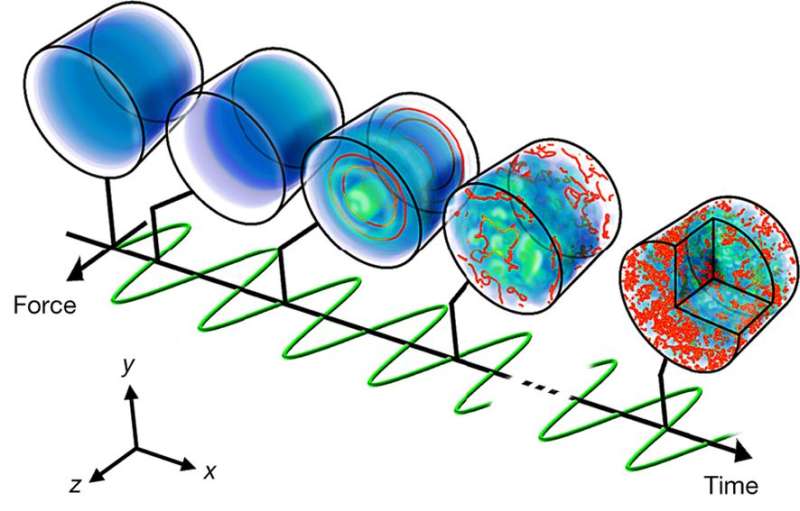November 3, 2016 report
Producing turbulence in a Bose-Einstein condensate yields cascade of wave-like excitations

(Phys.org)—A team of researchers at the University of Cambridge has succeeded in creating turbulence in a Bose–Einstein condensate (BEC) and in the process, have possibly opened the door to a new avenue of research. In their paper published in the journal Nature, the team describes how they achieved this feat and the evidence they found for a cascade. Brian Anderson with the University of Arizona offers a News & Views piece describing the work done by the team in the same journal issue and offers a brief overview of the characteristic distribution of kinetic energy in turbulent fluids.
Scientists have learned a lot about the nature of turbulence in fluids over the past several hundred years, some of which surrounds the way kinetic energy is distributed among components that have different momenta—which can be seen in action, as Anderson notes, by stirring cream into a cup of coffee. But until now, no one had succeeded in producing turbulence in a BEC, in which a gas of bosons is cooled to near absolute zero causing them to occupy the lowest possible quantum state, thereby allowing for viewing quantum phenomena—Anderson calls them "microscopic droplets of atomic gasses."
In this new effort, the researchers conducted experiments designed to discover what might happen if turbulence were introduced to a BEC, in this case, one made of rubidium atoms captured in a laser-created virtual box—this type of setup provided uniform density of the atoms. The team then applied a timed magnetic field that served to shake up the cloud of atoms, which added energy to the system. They then determined the momentum distribution. For small time intervals, they found most of the atoms in the cloud were in a low-momentum mode—more shaking pushed the atoms into a higher momentum mode. After approximately two seconds, the researchers found evidence of a cascade of excitations by releasing the cloud and capturing what occurred with a 2-D camera.
The method used by the team to cause the turbulence in a BEC is likely to be used as a model for future experiments involving quantum turbulence.
More information: Nir Navon et al. Emergence of a turbulent cascade in a quantum gas, Nature (2016). DOI: 10.1038/nature20114
Abstract
A central concept in the modern understanding of turbulence is the existence of cascades of excitations from large to small length scales, or vice versa. This concept was introduced in 1941 by Kolmogorov and Obukhov, and such cascades have since been observed in various systems, including interplanetary plasmas, supernovae, ocean waves and financial markets. Despite much progress, a quantitative understanding of turbulence remains a challenge, owing to the interplay between many length scales that makes theoretical simulations of realistic experimental conditions difficult. Here we observe the emergence of a turbulent cascade in a weakly interacting homogeneous Bose gas—a quantum fluid that can be theoretically described on all relevant length scales. We prepare a Bose–Einstein condensate in an optical box, drive it out of equilibrium with an oscillating force that pumps energy into the system at the largest length scale, study its nonlinear response to the periodic drive, and observe a gradual development of a cascade characterized by an isotropic power-law distribution in momentum space. We numerically model our experiments using the Gross–Pitaevskii equation and find excellent agreement with the measurements. Our experiments establish the uniform Bose gas as a promising new medium for investigating many aspects of turbulence, including the interplay between vortex and wave turbulence, and the relative importance of quantum and classical effects.
Journal information: Nature
© 2016 Phys.org




















